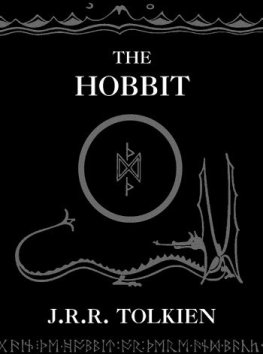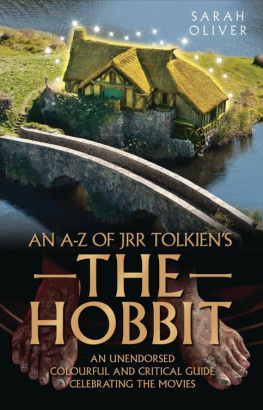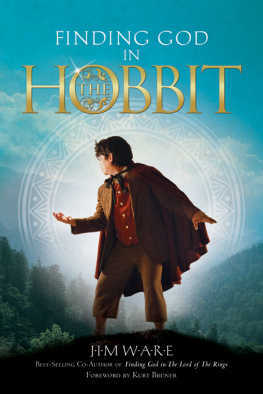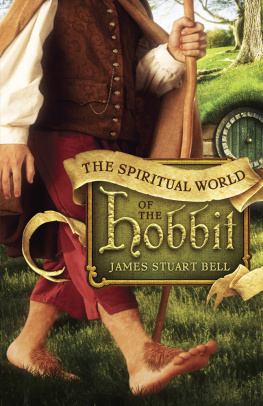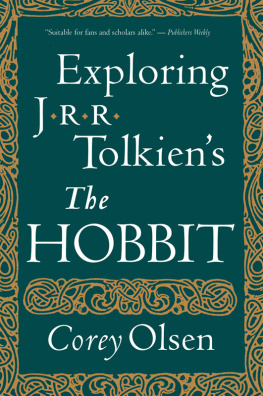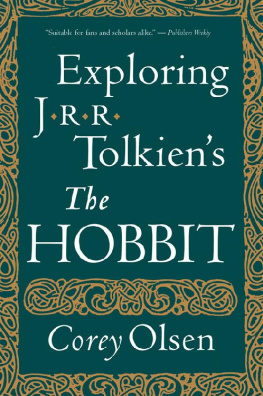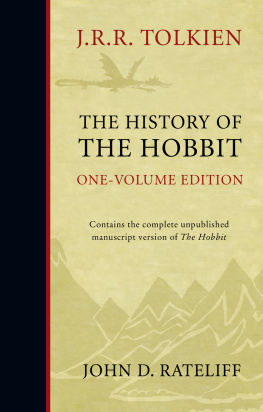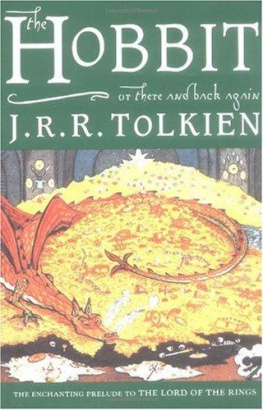
THE HOBBIT
OR
THERE AND BACK AGAIN
BY
J.R.R. TOLKIEN

Houghton Mifflin Harcourt
Contents
AUDIO
Colour by H. E. Riddett

THE HOBBIT was first published on 21 September 1937, and for its fiftieth anniversary edition Rayner Unwin suggested to me that it would be of interest to include in it some unpublished or little known illustrations by my father, and also one of three manuscript sheets (each written on both sides, making six pages in all) that alone survive today of the original draft of the first chapter, An Unexpected Party . This particular sheet was preserved, no doubt, because on it there was also the first sketch of Thrors Map. This preface is mostly concerned with this text and with pictures and designs; an account of the writing of The Hobbit (or what can be known of it) and the story if its publication are given by Humphrey Carpenter in J.R.R.Tolkien: A Biography , pp. 177-82.
On the now very battered manuscript sheet reproduced on the following pages my father afterwards wrote: Only page preserved of the first scrawled copy of The Hobbit which did not reach beyond the first chapter. Since the writing is indeed a scrawl and very hard to read, I set it out in print here. The text will be found to correspond, with many differences, to that in this book on pp. 20-1, but if the bottom of the second side of the sheet was the end of the text the entire history related by Gandalf and Thorin Oakenshield had yet to emerge.

A page from the earliest manuscript of The Hobbit
Why?
Because it is too small. Five feet high is the door, and three abreast [ first written four abreast] may enter it say the runes. But Pryftan could not creep in a hole that size, not even when he was a young dragon, certainly not after he had devoured so many maidens of the valley.
It seems a pretty big hole, piped Bilbo. He loved maps, and in the hall there was a large one of the County Round (where he lived), with all his favourite walks marked on it in red ink. He was so interested he forgot to be shy and keep his mouth shut. How could such an enormous door (he was a hobbit, remember) be secret?
Lots of ways, said Bl[adorthin], but which one of them we dont know without looking.
At the top of the other side of the page there is a list of the dwarves, which includes Gandalf; and against this my father afterwards wrote in pencil: NB Gandalf was originally chief Dwarf (=Thorin) and Gandalf was called Bladorthin. The names of the dwarves in The Hobbit were taken from verses of a very ancient Norse poem called Vlusp , where many dwarf-names are given, and among them Gandalf . The only other difference in this original list is that Oi appears for Ori (in the Vlusp there is the name i ). Bladorthin became the name of a long-dead king who is mentioned once in The Hobbit (p. 230) but nowhere else.

A page from the earliest manuscript of The Hobbit
From what it says on the map I should say that there is a closed door which looks just like the side of the mountain the ordinary dwarfs way (I think I am right?)
Quite, said Gandalf. But this rather alters things. There are fourteen of us unless you are coming, Bladorthin. I had thought of going up along Running River from the Long Lake if we can get so far! and so to the Ruins of Dale Town. But we none of us liked the idea of the Front Gate. The River runs out of that great door, and out of it the Dragon comes too. Far too often.
That would have been no good, said Bl[adorthin], without a mighty warrior; even a hero. I tried to find one, but I had to fall back (I beg your pardon, but I am sure you will understand dragon-slaying is not I believe your speciality) to fall back on little Bilbo [ first written Mr Baggins].
The burglar, said Dwalin. Precisely, said Blad[orthin], not allowing Bilbo time to object. I told you last Thursday it would have to be a burglary not a battle, and a burglar I promised to find. I hope no one is going to say I put the sign on the wrong door again. He frowned so frightfully at Bilbo that the little man darent say anything though he was bursting with questions.
Warriors are very busy fighting one another in far lands, went on Bl[adorthin], and in this neighbour-hood there are none or few [ struck out : left, of men, dwarves, elves or hobbits], not to speak of heroes. Swords in the world are mostly blunt, and axes used on trees and shields for dish-covers, and dragons comfortably far-off. But burglary is I think indicated in any case by the presence of the back door.
What is your plan? they all said. To go to the back door, sit on the step and think of one if one does not sprout up on the way, said the wizard. There is no time to lose. You must be off before daybreak and well on your way.
I cannot read the last word, unless it is Dwarves. This text is in fact slightly nearer to that of The Hobbit as it was originally published than to the text in this book (many changes were made in the editions of 1951 and 1966): for instance, in the book as it came out in 1937 Smaug is still said to have devoured so many maidens of the valley.
Turning now to the map which accompanies the text, the runes beside the pointing hand read:
FANG THE SECRET PASSAGE OF THE DWARVES
I do not know how to interpret the first word. It certainly begins fa , and the third rune seems to be that called in Old English Ing, with the value ng (it is found in the word setting in the Moon-runes on Thrors Map as published). Conceivably it was to be the name of the passage and the rune for f stands against the back door on the map.
Beneath the runes is five feet high the door and three may walk abreast, and then a first draft of the text of the Moon-runes read by Elrond (p. 55): Stand by the grey stone when [ or where] the crow knocks and the rising sun at the moment of dawn on Durins Day will shine upon the key hole. The last word is struck through, and thrush is written above crow . The thrush is described (p. 209) as enormous and nearly coal-black (but with a pale yellow breast freckled with dark spots). Then follows a second text of the Moon-runes, which was scarcely changed afterwards; but this certainly has where the thrush knocks, and in the original edition Elrond read it as where, although the actual runes on Thrors Map had when.
It will be seen that the form of the mountains spurs were very much [the] same as they appear on Thrors map as published (with the height of Ravenhill at the end of the southern spur and the camp beneath it); but the ruins of Dale are on the east side of the River Running, since they were not enclosed within a great eastward loop of the river. The device at the top of the map apparently represents the points of the compass, with the seven stars of the Great Bear in the North (the black spots to the left of the stars are merely marks on the paper), the Sun in the South, the Misty Mountains in the West and (I think) the entrance to the Elvenkings halls in the East. The names at the bottom of the page, Mirkwood, marshes, and Lake Town, and the camp below the mountain, were added in at the same time as the second version of the text of the Moon-runes. At the bottom on the right is the first actual sketch of the Lonely Mountain, added in pencil.
Next page


